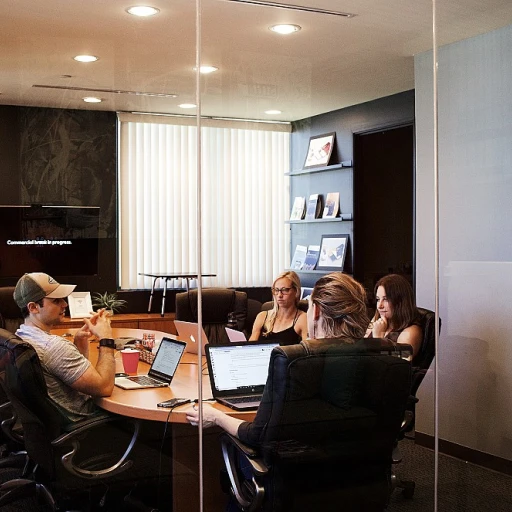Understanding Office Space Planning
The Basics of Space Planning for Modern Offices
Office space planning is the backbone of an effective workplace. It involves determining the layout and design of office spaces to optimize productivity, enhance employee well-being, and make the best use of available resources. While it's easy to overlook this aspect, a well-thought-out office layout has the power to transform how a business operates. By focusing on the arrangement of furniture, technology, and workstations, companies can create an atmosphere that supports collaboration and innovation.
Key Considerations for Effective Space Planning
There are several elements to consider in office space planning. These elements not only shape the look and feel of the work environment but also hold the potential to significantly impact productivity levels and employee satisfaction. Here are some crucial factors:
- Workplace Culture: Every organization has its unique culture, and the office design should reflect this. It's essential to design spaces that resonate with the values and practices of your team.
- Employee Needs: Employees spend a large part of their day in the office, and it's vital to cater to their professional and personal needs. This includes ergonomic furniture for comfort and dedicated spaces for breaks.
- Technology Integration: In our digital age, seamless integration of technology is non-negotiable. Consider positioning workstations to capitalize on natural light while maintaining the necessary tech accessibility and connectivity.
The Balance between Aesthetic and Functionality
An efficient office space planning strategy strikes a balance between aesthetic appeal and functionality. While it’s tempting to opt for the most visually stunning options, it's crucial to ensure that the space remains conducive to work. Everything from choosing paint colors to selecting furniture influences how employees interact with their environment and each other.
Learn from Office Cleanliness Success
An often overlooked aspect of office space planning is maintaining the benefits of a clean environment. Office cleanliness is crucial for maintaining employee health and productivity levels. To dive deeper into how this impacts office space planning, consider reading about
finding the best office cleaning service companies. Implementing regular cleaning schedules ensures that the workspace remains inviting and operational.
Stay tuned for our upcoming sections where we will delve into office design’s significance and how professional planning services can streamline your approach to creating the perfect workplace environment.
Why Office Design Matters
The Impact of Thoughtful Office Design
When we consider the importance of thoughtful office design, it's easy to see how it can enhance productivity and employee satisfaction. A well-designed office space does more than merely look good - it affects how employees feel and perform at work.
- Boosts Morale: An appealing office environment can lead to happier employees, as they enjoy coming to work in an attractive and comfortable setting.
- Increases Collaboration: Open spaces and strategically placed communal areas encourage interaction and foster teamwork.
- Reduces Stress: Incorporating natural elements like plants and sunlight can help create a calm atmosphere, reducing stress and promoting well-being.
Paying attention to office design also shows employees that their company values them, which can lead to increased loyalty and retention.
Key Elements to Consider
In planning your office space, several elements come into play that can significantly impact its success:
- Layout: Your office layout should be aligned with your company's work style. Consider factors such as departments' proximity, traffic flow, and available quiet spaces.
- Lighting: Proper lighting is essential for reducing eye strain and maintaining energy levels. Natural light is optimal, but quality artificial lighting is crucial in areas where daylight is limited.
- Colour Scheme: Colours can affect mood and productivity. Blues and greens are known to have calming effects, while splashes of brighter colours can energise employees.
Integrating these aspects into your office design can facilitate a more enjoyable and efficient working environment.
For businesses in the UK aiming to enhance their workspace, ensuring efficient office supply delivery is crucial to maintaining a seamless workflow.
Explore more about efficient delivery services and how they contribute to a smooth office operation.
The Role of Office Furniture in Space Planning
The Impact of Ergonomic Furniture Choices
When it comes to mastering office space planning, the selection of office furniture plays an essential role in creating an efficient and productive work environment. Ergonomic furniture isn't merely a trend; it’s a necessity for the modern office aiming to prioritize employee well-being and enhance productivity.
Consider the effect that adjustable desks and chairs have on staff comfort. Properly selected furniture can minimize physical strain and prevent common workplace injuries. This not only boosts employee satisfaction, but it can also decrease absenteeism, contributing to a more dynamic and engaged workforce.
Enhancing Collaboration with Thoughtful Layouts
Office furniture shouldn't just be functional; it should also facilitate collaboration. In the context of
an in-depth look at workplace planning, flexible and movable furniture options allow teams to easily regroup and foster collaboration without being hindered by a rigid environment.
Think about furniture arrangements that encourage spontaneous interactions among team members. For example, strategically placed standing meeting tables make informal discussions possible, fostering creativity and knowledge sharing among colleagues.
Balancing Professional Aesthetics and Usability
It’s vital to ensure that furniture aligns with both the aesthetic and operational goals of the office. Balancing professional appearance with practical usability creates an inviting space that reflects the company culture while meeting the daily needs of employees.
Take the time to choose materials and designs that not only support your brand image but are also durable and easy to maintain. With careful selection, office furniture becomes a key element in the broader strategy of creating a flexible and adaptable work environment.
Utilizing professional office space planning services can further enhance these choices, guiding you to make informed decisions that align with both current needs and future growth.
Creating a Flexible Work Environment
Adaptable Workspaces for a Dynamic Office
Creating a flexible work environment is essential in today’s fast-paced world. As businesses evolve, so do their workspace needs. Here's how you can ensure your office remains versatile and accommodating:
- Multi-purpose Areas: Designing spaces that serve multiple functions can maximize output. Whether it's a conference room doubling as a collaborative workspace or a lounge area that supports informal meetings, versatility is key.
- Modular Furniture: Invest in office furniture that can be easily rearranged or reconfigured. This allows employees to adapt their workspaces according to their tasks or preferences, enhancing productivity.
- Technological Integration: With an increasing reliance on digital tools, creating a workspace that supports technology is non-negotiable. Ensure that your office has sufficient charging stations, USB ports, and other tech-friendly amenities.
- Remote and Hybrid Work Options: Designing spaces that accommodate remote workers when they are on-site can help maintain an inclusive culture. This might include hot-desking opportunities or dedicated areas equipped for video conferencing.
- Zoning for Different Work Styles: Distinct zones can cater to various work styles, such as quiet zones for focused work, collaborative areas for group projects, and casual zones for relaxation or informal catch-ups. Ensure your office design supports a wide range of activities.
Incorporating these elements not only supports the current needs of a modern office but also prepares it for future changes. A flexible workspace is a proactive approach to business growth and employee satisfaction.
How Professional Planning Services Can Help
Maximise Efficiency with Expert Planning Advice
When it comes to optimising your office space, professional planning services can be a game-changer. These services are invaluable as they bring expertise and innovative solutions to the table, transforming your office layout into a more efficient and functional work environment. With expert planning advice, you can effectively address challenges related to space constraints, workflow disruptions, and employee well-being.
Customised Solutions for Unique Needs
Professional planners understand that each business is unique, and thus, requires tailored solutions. By evaluating your specific needs and goals, they devise strategic plans to make the best use of available space. Whether it’s enhancing collaborative areas or creating quiet zones for focused work, customised solutions ensure that your office environment aligns with your team’s dynamics.
Future-Proofing Your Work Environment
In today’s fast-paced world, flexibility is key. Professional planners design spaces that are adaptable to future changes, such as business growth or technological advancements. This forward-thinking approach helps maintain a productive atmosphere without the need for frequent and costly redesigns.
Considering the importance of office space planning, engaging professional services can turn your workplace into a hub of productivity and employee satisfaction, offering both immediate improvements and long-term benefits.
Real-Life Success Stories
Success Stories: Transformations and Achievements
When discussing office space planning services and their impact, it is essential to explore real-life success stories that highlight the tangible benefits companies have experienced. These examples demonstrate how thoughtful planning and design can significantly enhance workplace efficiency, employee satisfaction, and overall company success.
One notable success story is of a tech company that was struggling with a cramped and cluttered workspace, leading to decreased productivity and employee dissatisfaction. By engaging professional office space planners, the company was able to rethink their office layout and implement a more functional and improved design. The introduction of ergonomic furniture and multi-functional meeting spaces not only increased the comfort of the employees but also fostered better collaboration and communication among teams.
Another example involves a customer support center that underwent a significant transformation. Initially characterized by dull cubicles and lack of natural lighting, the space was redesigned with vibrant colors, open-concept seating, and strategically positioned common areas. This change revitalized the workspace atmosphere and resulted in a marked improvement in staff morale and customer service levels.
These stories underscore the importance of strategically designed spaces, as discussed in the other parts of this article, including how office design matters and the role of furniture in planning. By leveraging professional space planning services, companies can effectively optimize their work environments, resulting in a multitude of benefits that ultimately contribute to their long-term success.

